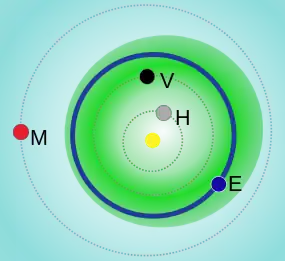Apollo asteroid
The Apollo asteroids are a group of near-Earth asteroids named after 1862 Apollo, discovered by German astronomer Karl Reinmuth in the 1930s. They are Earth-crossing asteroids that have an orbital semi-major axis greater than that of the Earth (a > 1 AU) but perihelion distances less than the Earth's aphelion distance (q < 1.017 AU).[1][2]

|
Mars (M) Venus (V) Mercury (H) |
Sun Apollo asteroids Earth (E) |
As of February 2023, the number of known Apollo asteroids is 17,540, making the class the largest group of near-Earth objects (cf. the Aten, Amor and Atira asteroids),[3] of which 1,571 are numbered (asteroids are not numbered until they have been observed at two or more oppositions), and 1,976 are identified as potentially hazardous asteroids.[4]
The closer their semi-major axis is to Earth's, the less eccentricity is needed for the orbits to cross. The Chelyabinsk meteor, that exploded over the city of Chelyabinsk in the southern Urals region of Russia on February 15, 2013, injuring an estimated 1,500 people with flying glass from broken windows, was an Apollo-class asteroid.[5][6]
List
The largest known Apollo asteroid is 1866 Sisyphus, with a diameter of about 8.5 km. Examples of known Apollo asteroids include:
See also
- Alinda group
- Amor asteroid
- Apollo asteroids (category)
- Apollo asteroid records
- Aten asteroid
- List of minor planets
- 2020 PP1
References
- "Near-Earth Object Groups". JPL – NASA. Archived from the original on 2 February 2002. Retrieved 11 November 2016.
- Weisstein, Eric. "Apollo Asteroid". Wolfram Research. Retrieved 27 February 2013.
- "NEO Discovery Statistics". Archived from the original on 13 May 2004. Retrieved 11 November 2016.
- "Small-Body Database Query". Solar System Dynamics - Jet Propulsion Laboratory. NASA - California Institute of Technology. Retrieved 2023-02-01.
- Cantor, Matt (26 February 2013). "Scientists figure out Russia meteor's origin". USA Today. Retrieved 11 November 2016.
- Jacob Aron (26 February 2013). "Russian meteor traced to Apollo asteroid family". New Scientist. Retrieved 11 November 2016.
- The Spacewatch Project, Arizona Board of Regents, 2010